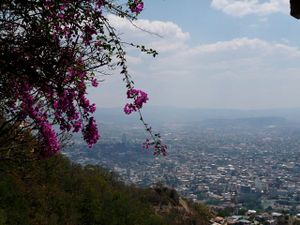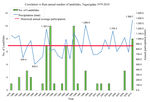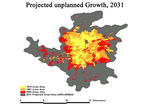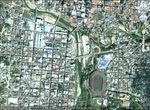Group P - Collaborative Climate Adaption Project: Difference between revisions
| Line 130: | Line 130: | ||
The average sunshine hours per month during the year is 211.2 and the average rainy days per month is 8.9. The average sunshine hours during the dry season is 228 per month while 182.5 millimetres (7.19 in) is the average monthly precipitation during the wet season. The wettest months of the rainy season are May—June and September—October, averaging 16.2 rainy days during each of those periods. [http://www.en.wikipedia.org/wiki/Tegucigalpa#cite_note-73] | The average sunshine hours per month during the year is 211.2 and the average rainy days per month is 8.9. The average sunshine hours during the dry season is 228 per month while 182.5 millimetres (7.19 in) is the average monthly precipitation during the wet season. The wettest months of the rainy season are May—June and September—October, averaging 16.2 rainy days during each of those periods. [http://www.en.wikipedia.org/wiki/Tegucigalpa#cite_note-73] | ||
<gallery caption=" " widths="250px" heights="150px" perrow="6"> | |||
Image:TemperatureChartt.jpg|Annual Average Temperature of Tegucigalpa [http://en.wikipedia.org/wiki/Tegucigalpa#cite_note-73] | |||
</gallery> | </gallery> | ||
Revision as of 13:07, 13 January 2013
| Area | please enter the area name here | |
| Place | Tegucigalpa | |
| Country | Honduras | |
| Topic | please enter the topic here | |
| Author(s) | Please enter your name(s) | |

| ||
|
| ||
Rationale: Why have you selected this case study area?
Honduras is the second poorest country in Latin America and nominated by the World Bank Organization as the third most vulnerable country in the World.[6] Despite of its great climate conditions, in 2011 Honduras’s Government had to call for State of Emergency every 38 days. [7] Most of its vulnerability is due to its poor infrastructure, high population growth rate, unemployment which results in criminality, its inexistent land and city planning, and its increasing annual precipitation. Tegucigalpa, itself is a mirror of poor planning. Most of the city’s neighborhoods are located on places where buildings were not plausible. Most of Tegucigalpa’s soil conditions are poor for construction purposes and often result in erosion. Tegucigalpa’s topography and poor drainage infrastructure often cause the city to be flooded and this is terrible considering that Honduras has a high annual precipitation.
Authors' perspectives
It is very diffcult to explain the complexity of Honduran reality. Honduras suffers what
most of 3rd world countries suffer: Considerable Social Wealth distribution differences, Political
crisis, high assassination rates and no future planning. The climate change problems will
affect primarily those with poor economic incomes, which live in the areas, which were
not planned or meant to be occupied. The social and security problems maintain the
average Honduran distracted from concerning on Climate change. Natural Disasters then
happen and thousands of people loose their homes, others suffer severe damage on their
working facilities and the aid never gets to them because it’s lost in bureaucratic stages
and the system’s corruption.
Little investigation has been done in Honduras regarding on Climate Change although
there has been an increase in annual precipitation during the last years in winter and
much more droughts during summer. To make this worse, Honduras has being absorbed
by the political crisis originated by the Coup d’état in 2009, the emergence of a socialist
political power, Venezuela’s political interference and plenty of assassinations to lawyers,
journalists, political leaders and policemen. All this social confict that is perceived more in
Tegucigalpa (political capital from Honduras), has obsessed Hondurans overshadowing
other important issues as natural disasters mitigation.
It’s also widely known that Latin-American culture and planning are like water and oil. The Honduran
carefree way of living has resulted on poor response to natural disasters, long-term
recuperation from hurricanes, earthquakes and foods.
Landscape and/or urban context
Tegucigalpa, Honduras’s capital has a population of over a million habitants. The Choluteca River crosses the city from north to south (which often floods the city’s downtown and poor residential areas). There is no landscape design related to Tegucigalpa’s rivers, surrounding mountains, historical center and statues. Few parks are found on the downtown with very little maintenance. The city has adopted the Consumerism-individualistic life-style in which cars are more important than pedestrians. No planning has been developed for Tegucigalpa’s rapid urban growth, which causes plenty of traffc. The public transportation system is also very defcient and has no well structured circuits. Tegucigalpa hasn’t any main Bus station but many stations that are located on the most dangerous neighborhoods. Most of the houses built in Tegucigalpa must have a perimeter wall protecting the inhabitants from criminality. These walls often include security cameras, electrical wire and house alarms. Tegucigalpa’s topography is variable, its surrounded by mountains and hills and the lowest point is at the city’s downtown. All the water from precipitation and drainage ends up here. Tegucigalpa also suffers from constant erosion due to its poor soil conditions and the invasion of poor people to these areas were they build houses without any quality control.
Cultural/social/political context
As mentioned above, Honduras political crisis is a conversation subject for every
Honduran. Two conservative parties have governed Honduras during the last 100 years,
and military coups took place 30 years ago. However, during the presidential period
between 2006 and 2010, Manuel Zelaya, the former president change the direction of its
government from conservative to socialist due to his alliance with Hugo Chavez. This
resulted in a considerate popular discontent in some social sectors as the religious
groups, conservative groups and other fnancial groups. These groups eventually forced
Zelaya to quit the presidency because he had plans to change the constitution and
remain as president, which ended up as the 2009 coup d’etat. Since then, Zelaya was
forced to leave the country and other social groups decided to create a socialist political
party to change Honduras’s Status Quo. From 2009, many assassinations to journalists,
lawyers, political and religious leaders have taken place. The criminality rate has
increased converting Honduras in the country with the highest criminality rate all over the
world. Poverty reaches 80% of Honduras' population, 1/3 of the working population
is unemployed. Social differences are big and the poor often suffer more from natural
disasters such as floods and hurricanes, as those conforming the middle-class and highclass
sectors.
Generally, the public services are defcient and Hondurans choose (when economically
possible) to use private services such as education, transportation and health.
Most of Honduran traditions are related to its past as a former Colony from Spain and to
roman catholic traditions. Other traditions come from its different ethnical groups such as
the Garifunas (slaves who where brought from Africa) and other native indian groups.
Honduras is also famous for being part of the Mayan civilization and having plenty of mayan
ruins on its occidental part.
Illustration: Bullet points, image, background notes
Local Climate
Honduras is characterized by its tropical climate throughout the year, which is divided in two subcategories: in its coasts it’s rainy tropical and tropical dry in its central region. Nevertheless, Honduras’s annual precipitation varies from 1900mm to 2500mm. The average temperature is 23º C but in March and April it can get to 40ºC and 15ºC during December and January. There are only two seasons in Honduras; the dry season, which takes places between November and March and the rainy season from May to October.
Teguicigalpa features a more moderate form of a tropical wet and dry climate. Of the major Central American cities, Tegucigalpa's climate is among the most pleasant due to its high altitude. Like much of central Honduras, the city has a tropical climate, though tempered by the altitude—meaning less humid than the lower valleys and the coastal regions—with even temperatures averaging between 19 °C (66 °F) and 23 °C (73 °F) degrees.[[8]] The months of December and January are coolest, with an average min/ low temperature of 14 °C (57 °F); whereas March and April—popularly associated with Easter's holidays—are hottest and temperatures can reach up to 40 °C (104 °F) degrees on the hottest day.[9] The dry season lasts from November through April and the rainy season from May through October.[10] There is an average of 107 rainy days in the year, June and September usually the wettest months. The average sunshine hours per month during the year is 211.2 and the average rainy days per month is 8.9. The average sunshine hours during the dry season is 228 per month while 182.5 millimetres (7.19 in) is the average monthly precipitation during the wet season. The wettest months of the rainy season are May—June and September—October, averaging 16.2 rainy days during each of those periods. [11]
- TemperatureChartt.jpg
Annual Average Temperature of Tegucigalpa [3]
Analysis of vulnerability
Tegucigalpa’s vulnerability is due to these factors:
- Poor drainage infrastructure:Tegucigalpa's authorities have not done many changes to the drainage infrastructure in Tegucigalpa since the 1970's, nevertheless its population increased in more than a 200%.[12] This results on constant stagnant water, and difficulty to get the rainwater away from the streets and residential areas.
- Existing residential areas located in erodible and hard to reach places:Poor planning and supervision has permited poor citizens to develop poor residential areas in dangerous parts of the city, which have poor soil conditions and no infrastructure.
- Constant ground invasion in dangerous topographical zones:The economical crisis and the uncontroled birth rate had cause Honduran population to increase in a very rapid rate without any social and economical development to absorb it. This causes many hondurans to move to invade zones with no land values but put in risk their lives because of the constant natural disasters.
- No planning related to flooding, evacuation and containment of landslides Tegucigalpa authorities as well as the local government have not yet developped sustainable strategies dealing with:
- Tegucigalpa's urban growth
- Mitigation and adaptation to Natural Disasters
- Improving the citizens living conditions and public spaces
Correlation number of landeslides vs Number Precipiation Monthly average and maximum, Tegucigalpa [4]
Project Planned Growth, 2031 [5]
Proposals for Climate Change Adaption
- How could your case study area become more resilient to climate change?
- Which measures would need to be taken to adapt to the new situation?
- How could you assure sustainability of these measures?
- Please describe 2-3 measures
Proposals for Climate Change Mitigation
- Which measures would need to be taken to reduce greenhouse gas emissions and other drivers of climate change within your case study area?
- How could you assure sustainability of these measures?
- Please describe 2-3 measures
Your scenario
- How will this area look like in 2060?
- Please forecast one potential future development taking climate change into account
Illustration: Map/diagram/sketches photos and background notes
What can be generalized from this case study?
- Are there any important theoretical insights?
- Which research questions does it generate?
- Short statement plus background notes
Image Gallery
- Yourimage.jpg
your image text
- Yourimage.jpg
your image text
- Yourimage.jpg
your image text
- Yourimage.jpg
your image text
- Yourimage.jpg
your image text
References
Please add literature, documentations and weblinks
- [13]
- [14]
- [15]
- [El Heraldo December 5 2011. https://www.elheraldo.hn/Secciones-Principales/Al-Frente/Cada-38-dias-el-gobierno-del-presidente-Porfirio-Lobo-emite-un-estado-de-emergencia]
- [La Prensa 26.10.2010 https://archivo.laprensa.hn/Pa%C3%ADs/Ediciones/2010/10/26/Noticias/130-000-familias-en-riesgo-por-clima-en-Tegucigalpa]
- [16]
- [Rapid Urbanization in Tegucigalpa, Honduras, Shlomo Angel with Katherine Bartley, Mary Derr, Anshuman Malur, James Mejía, Pallavi Nuka, Micah Perlin, Sanjiv Sahai,
Michael Torrens, and Manett Vargas, Princeton University, February 2004]
About categories: You can add more categories with this tag: "", add your categories
![Land Use in Tegucigalpa Urban Area[1]](/images/thumb/a/ac/Land_Use_Percent.jpg/150px-Land_Use_Percent.jpg)
![Land Use in Tegucigalpa Urban Area[2]](/images/thumb/c/c9/Analysis_of_Landuse_.jpg/150px-Analysis_of_Landuse_.jpg)

![Correlation number of landeslides vs Number Precipiation Monthly average and maximum, Tegucigalpa [4]](/images/thumb/4/49/SAT_deslizamientos_TGU-7.jpg/150px-SAT_deslizamientos_TGU-7.jpg)

![Project Planned Growth, 2031 [5]](/images/thumb/d/db/Projected_planned_growth.jpg/150px-Projected_planned_growth.jpg)


